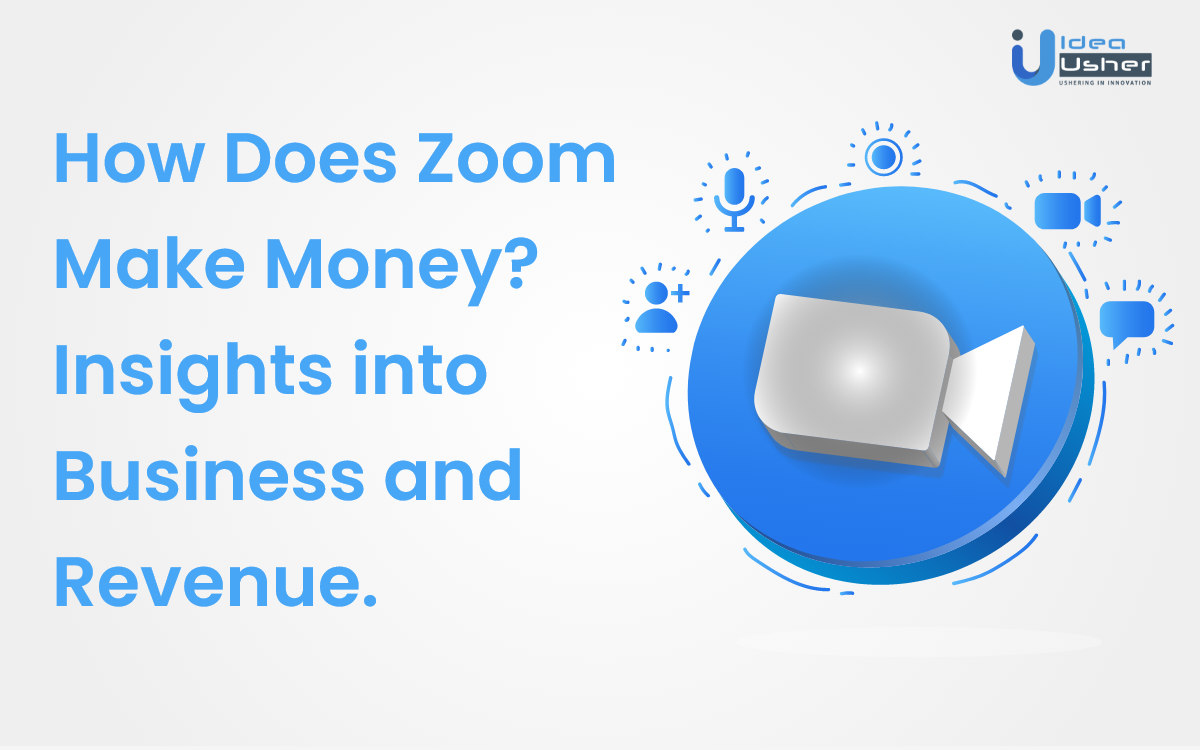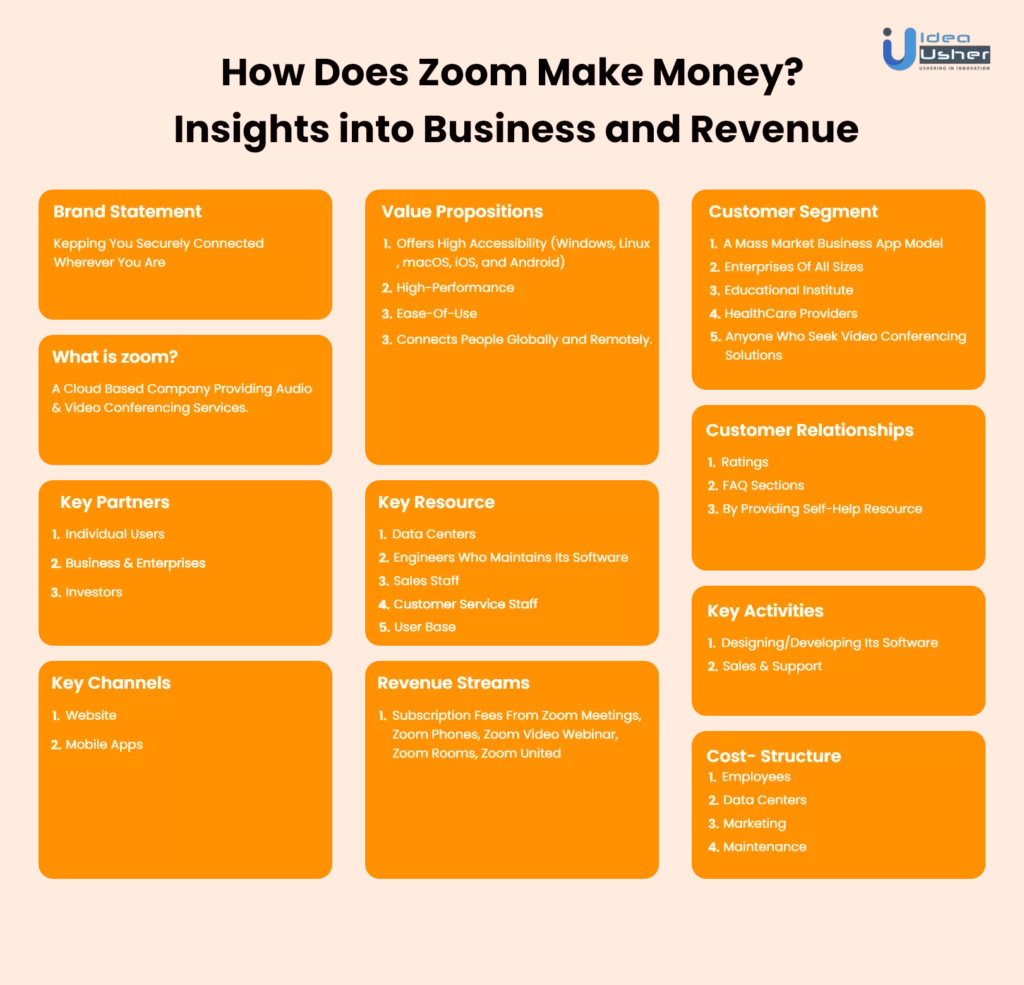
Entrepreneurs and businesses looking forward to venturing into the video conferencing industry have only one question – How Does Zoom Make Money?
During this COVID-19 pandemic, start-ups, MNCs, educational institutions, healthcare providers, and anyone who wanted to communicate by video conferencing opted for Zoom Meetings predominantly. For such reasons, the company reached new heights with social distancing and remote working being implemented worldwide.
As per the reports by SensorTower of the Top Apps Worldwide for 2020 by Downloads, Zoom made it to the top list in all the three categories: App Store Downloads, Google Play Downloads, and Overall Downloads.
If you’re an entrepreneur or a business that wishes to replicate an application like Zoom, then you’re at the right place.
This blog post will give you insights into the business and revenue models of Zoom and ultimately give you the answers to your question, “How Does Zoom Make Money?“
Let’s get started.
Zoom Facts and Stats
| Founded | April 21, 2019 |
| Headquarters | San Jose, California, United States |
| Founder | Eric Yuan |
| Services | Videotelephony, Business Telephone Systems, Online Chat |
| Business Model | Freemium Model |
| Number of Investors | 18 |
| Total Funding Amount | $148M |
| Employees | 2.532 (2020) |
| Website | https://zoom.us/ |
Success Timeline – Early History and Growth

Before we understand How Does Zoom Make Money, let’s have a quick look at Zoom’s success timeline – its early history, growth, and success.
2011
Eric Yuan (founder of Zoom) left Cisco Webex in April, where he worked as a corporate vice president to start a new company with 40 engineers. Zoom was initially named Saasbee, Inc.
In June, the company raised $3M of seed money from Subrah Iyer (founder of WebEx), Dan Scheinman (former Cisco SVP and General Counsel), and Matt Ocko, TSVC, Bill Tai (Venture Capitalists)
2012
After changing Saasbee, Inc. to Zoom in May, the company decided to launch a beta version of its program in September, which could host conferences with up to 15 participants.
Stanford University became Zoom’s first customer in November.
2013
Zoom finally set up its services and raised $6M in Series A round of funding in January. It launched version 1.0 of the program, which increased the total number of conference participants to 25. Moreover, it had 400,000 users by the end of the first month.
Over the months, Zoom established partnerships with many service providers. In September, it raised $6.5M in Series B round of funding. Besides, it had 3 million users at that time.
2015
Zoom raised $30M in Series C round of funding in February. Moreover, the total number of active users reached 40 million, and over 65,000 organizations subscribed to its services.
The company set up its version 2.5 in October, which enabled the users to host a conference with a maximum of 50 participants and 1,000 for the business plan subscribers.
2017
Zoom raised $100M in Series D round of funding in January and reached a $1B valuation.
Over the months, it launched various products such as telehealth and enabled features such as multiple screens and device meetings, calendar integration, etc. Moreover, it also took its first steps towards AI Speech Recognition programs.
2019
Zoom became a public company via an IPO. At the end of the trading, the company’s valuation raised to $16B.
As the COVID-19 pandemic started spreading in some countries, many companies, universities, and institutions switched to remote working, distance learning, and online social interaction. This led to a spike in the number of Zoom users.
2020
Zoom gained 2.22 million users by February, which was more than the number of users acquired in 2019 entirely.
In March, the number of daily meeting participants reached 300 million. Moreover, the company’s valuation stood at $67B by June.
By September, the stock prices surged by 569%, and the market capitalization stood at $129B. This number reached $140B by the end of October, making Zoom’s value higher than ExxonMobil, a 130-year-old company. However, Zoom witnessed a recent drop of 15% in the stock price in November.
Now that we’ve seen how Zoom has grown and achieved success over the past few years, let’s move on to knowing.
Business Model Explained

Zoom provides video telephony services, which means that it offers a platform to communicate with people via both audio and video in real-time. To understand How Does Zoom Make Money, we need to understand its business model.
It mainly targets businesses and enterprises of all sizes, healthcare providers, educational institutions, and anyone seeking video conferencing solutions. Therefore, these constitute the customer segments of Zoom.
Coming onto its value proposition, it offers high accessibility as it is available across all platforms (Windows, Linux, macOS, iOS, and Android), high-performance, ease-of-use, and most importantly, it connects people globally and remotely.
To sum it up, one can use Zoom for business meetings, training programs, online conferences, job interviews, webinars, etc., on any platform without any hassle.
Here’s the Zoom Business Model Canvas that gives you a brief overview of and how it works.

Get in touch with us today, and our experts will help you develop an application just like Zoom.
Additionally, Zoom operates on a freemium business model. Now, you may ask – “What is freemium?”
Freemium is a business model where the company provides limited services to its users without charging any fee. The intention behind providing these is to hook the customers and make them subscribe to the upgraded services.
Most of us think that Zoom is a basic video conferencing service. However, it is much more than that.
Let’s discuss each service separately so that we can understand Zoom generates revenue.
-
Zoom Meetings
Zoom Meetings is the company’s core offering, and it is also the most used service. It allows its users to communicate via video conferencing and offers a feature called Zoom Chat where-in the users can drop text messages, URLs, and other content.
Under this, there are four subscription models, namely:
-
-
Basic
-
This option is best for personal meetings. The best part is that it allows users to host a meeting with up to 100 participants free of cost. However, there’s a time limit of 40 minutes for the sessions. In contrast to this, the time for 1:1 meetings is unlimited.
This is the free variant of the Zoom meetings, and the company doesn’t charge for offering this service.
-
-
Pro
-
As this model offers unlimited group meetings, small teams can opt for this option and host meetings with up to 100 people without worrying about the time-limit. Additionally, it provides features such as social media streaming and 1 GB cloud recording.
This variant is chargeable and is priced at $149.90/year/license.
-
-
Business
-
This option is the best fit for small and medium businesses. This model allows hosting a group meeting with up to 300 participants in contrast to the above two. Additionally, it offers features such as single sign-on, cloud recording transcripts, company branding, and managed domains.
This variant is more expensive than the Pro model and is priced at $199.90/year/license.
-
-
Enterprise
-
This option allows users to host a meeting with 500 participants. Additionally, it offers unlimited cloud storage, a dedicated customer success manager, and transcription.
This variant is by far the most expensive one and is priced at $300.00/year/license.
Please note that the prices may vary depending upon your location and currency.
-
Zoom Phone
Zoom Phone makes the application a complete collaboration product for businesses and companies. It offers traditional phone capabilities within the application, making Zoom a one-stop solution for calling, messaging, and video conferencing.
Under this, there are four subscription models, namely:
-
-
US & Canada Metered
-
It offers a US and Canada number, and you can make and receive calls (metered) from multiple devices.
This variant is priced at $120.00/year/license.
-
-
US and Canada Unlimited
-
Apart from the previous model’s features, it provides unlimited calling within the US and Canada and offers advanced phone features.
This variant is priced at $180.00/year/license.
-
-
Pro Global Select
-
This variant offers unlimited domestic calling in more than 40 countries and territories and a direct dial number feature. Moreover, the previous model’s components are also included in this variant.
This variant is priced at $240.00/year/license.
Please note that the prices may vary depending upon your location and currency.
-
Zoom Video Webinar
Zoom Video Webinar allows users to host webinars with anywhere between 100 to 10,000 participants, depending on your pricing plan. It has interactive features such as polling, Q&A session, likes and upvotes, and so on. Besides, it also offers a list of features that businesses can make use of.
The pricing starts from $400.00/year/license and goes up to $64,900.00/year/license. Apart from this, if you wish to have a webinar with 10,000+ participants, you will be required to get in touch with Zoom’s sales team.
-
Zoom Rooms
Zoom Rooms is another video conferencing feature offered by the company; however, this helps the participants conduct the meeting more seamlessly and efficiently. It offers features such as one-click joining, 1080p HD video and audio, 1000 video participants or 10,000 webinar viewers, calendar integrations, and so on.
It offers a 30-day free trial for Zoom Rooms; however, it asks for your credit card information. Besides, the pricing starts from $499.00/year/license.
3 Things to Learn From Zoom
When Eric Yuan, the founder of Zoom, decided to start his journey back in 2011, he received a lot of criticism and his peers told him that he is making a “bad decision” as there were big players such as Skype in the market already. However, he looked past the limitations, decided to work on his dream project, and gave his target audience exactly what they needed. Fast forward today, Zoom has more users than Skype.
For these reasons, Zoom has inspired entrepreneurs and businesses all over the world. Taking notes about its business strategy and only focusing on “How Does Zoom Make Money?” may help you earn some revenue; however, it is the small lessons that you could learn from the company that would help you set apart from your competitors.
Let’s look at the 3 lessons that we can learn from the company.
-
Problem Faced by the Target Market
Although Skype is a great communication tool, the UX of the application is a bit complicated. Moreover, one needs to create a Skype account to join or host a meeting. Zoom identified these gaps and offered a product that provided solutions to these issues, i.e., one-click joining and an excellent UX.
-
‘A Product That Could Sell Itself’
Eric Yuan worked on building a product that could sell itself. He focused on the product’s features and built a robust application that his customers would love. Further, they targeted one key group – Early Adopters.
These are a bunch of people who are curious enough to try the product and spread the word, provided they love your product. Therefore, focus on your product’s features and functionality first instead of extensively spending money on marketing.
-
Free Services
Do you think Zoom would be where it is today had it not provided the free version of Zoom Meetings?
but only a handful of people want to focus on the free service, which is the most important aspect of the revenue strategy. To clarify, Zoom started earning money only after people got to know about the free service.
When users realized that they could get advanced features by getting an upgrade, they began subscribing to the other models, as discussed in the previous section. Therefore, do not hesitate to offer free services. It might help your product be the next favorite application!
Conclusion
That was all about How Does Zoom Make Money. After having gone through Zoom’s brief history, business models, revenue strategy, and key lessons, you must have understood why it is a market leader today. But, my point is – what is stopping you from converting your ideas into a world-class project?
Get in touch with us today, and our experts will help you develop an application just like Zoom.
Hope you liked our blog post on “How Does Zoom Make Money? Insights into Business and Revenue.”









Khushboo Rajpal